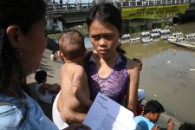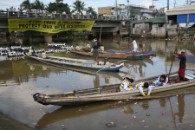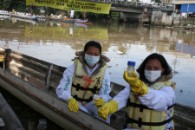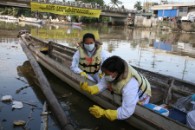notorious body of water to determine its exact toxicity levels.
 A Greenpeace volunteer talks to a local resident beside Marilao River in Bulacan 25 kilometers north of Manila. Marilao River has been identified by the Department of Environment and Natural Resources (DENR) as one of the Philippines’ 50 dead rivers due to heavy pollution. A team of Greenpeace ‘Water Patrol’ activists today called attention to the shocking extent of pollution in Marilao River by unfurling a 28-meter banner with the words “Stop toxic pollution, protect our water resources.” The activists also floated giant rubber fish skeletons along the river to underline the river’s death, as two volunteers in protective suits took water samples from the notorious body of water to determine its exact toxicity levels. Greenpeace recently launched ‘Project Clean Water’ which aims to bring people together toward a common goal of safeguarding our water sources.
A Greenpeace volunteer talks to a local resident beside Marilao River in Bulacan 25 kilometers north of Manila. Marilao River has been identified by the Department of Environment and Natural Resources (DENR) as one of the Philippines’ 50 dead rivers due to heavy pollution. A team of Greenpeace ‘Water Patrol’ activists today called attention to the shocking extent of pollution in Marilao River by unfurling a 28-meter banner with the words “Stop toxic pollution, protect our water resources.” The activists also floated giant rubber fish skeletons along the river to underline the river’s death, as two volunteers in protective suits took water samples from the notorious body of water to determine its exact toxicity levels. Greenpeace recently launched ‘Project Clean Water’ which aims to bring people together toward a common goal of safeguarding our water sources. A team of Greenpeace ‘Water Patrol’ activists today called attention to the shocking extent of pollution in Marilao River by unfurling a 28-meter banner with the words “Stop toxic pollution, protect our water resources” along Marilao Bridge in Bulacan province, 25 kilometers north of Manila. The activists also floated giant rubber fish skeletons along the river to underline the river’s death, as two volunteers in protective suits took water samples from the notorious body of water to determine its exact toxicity levels. Marilao River has been identified by the Department of Environment and Natural Resources (DENR) as one of the Philippines’ 50 dead rivers due to heavy pollution. Greenpeace recently launched ‘Project Clean Water’ which aims to bring people together toward a common goal of safeguarding our water sources. (c) Greenpeace/John Novis
A team of Greenpeace ‘Water Patrol’ activists today called attention to the shocking extent of pollution in Marilao River by unfurling a 28-meter banner with the words “Stop toxic pollution, protect our water resources” along Marilao Bridge in Bulacan province, 25 kilometers north of Manila. The activists also floated giant rubber fish skeletons along the river to underline the river’s death, as two volunteers in protective suits took water samples from the notorious body of water to determine its exact toxicity levels. Marilao River has been identified by the Department of Environment and Natural Resources (DENR) as one of the Philippines’ 50 dead rivers due to heavy pollution. Greenpeace recently launched ‘Project Clean Water’ which aims to bring people together toward a common goal of safeguarding our water sources. (c) Greenpeace/John Novis A team of Greenpeace ‘Water Patrol’ activists today called attention to the shocking extent of pollution in Marilao River by unfurling a 28-meter banner with the words “Stop toxic pollution, protect our water resources” along Marilao Bridge in Bulacan province, 25 kilometers north of Manila. The activists also floated giant rubber fish skeletons along the river to underline the river’s death, as two volunteers in protective suits took water samples from the notorious body of water to determine its exact toxicity levels. Marilao River has been identified by the Department of Environment and Natural Resources (DENR) as one of the Philippines’ 50 dead rivers due to heavy pollution. Greenpeace recently launched ‘Project Clean Water’ which aims to bring people together toward a common goal of safeguarding our water sources. (c) Greenpeace/John Novis
A team of Greenpeace ‘Water Patrol’ activists today called attention to the shocking extent of pollution in Marilao River by unfurling a 28-meter banner with the words “Stop toxic pollution, protect our water resources” along Marilao Bridge in Bulacan province, 25 kilometers north of Manila. The activists also floated giant rubber fish skeletons along the river to underline the river’s death, as two volunteers in protective suits took water samples from the notorious body of water to determine its exact toxicity levels. Marilao River has been identified by the Department of Environment and Natural Resources (DENR) as one of the Philippines’ 50 dead rivers due to heavy pollution. Greenpeace recently launched ‘Project Clean Water’ which aims to bring people together toward a common goal of safeguarding our water sources. (c) Greenpeace/John Novis A team of Greenpeace ‘Water Patrol’ activists today called attention to the shocking extent of pollution in Marilao River by unfurling a 28-meter banner with the words “Stop toxic pollution, protect our water resources” along Marilao Bridge in Bulacan province, 25 kilometers north of Manila. The activists also floated giant rubber fish skeletons along the river to underline the river’s death, as two volunteers in protective suits took water samples from the notorious body of water to determine its exact toxicity levels. Marilao River has been identified by the Department of Environment and Natural Resources (DENR) as one of the Philippines’ 50 dead rivers due to heavy pollution. Greenpeace recently launched ‘Project Clean Water’ which aims to bring people together toward a common goal of safeguarding our water sources. (c) Greenpeace/John Novis
A team of Greenpeace ‘Water Patrol’ activists today called attention to the shocking extent of pollution in Marilao River by unfurling a 28-meter banner with the words “Stop toxic pollution, protect our water resources” along Marilao Bridge in Bulacan province, 25 kilometers north of Manila. The activists also floated giant rubber fish skeletons along the river to underline the river’s death, as two volunteers in protective suits took water samples from the notorious body of water to determine its exact toxicity levels. Marilao River has been identified by the Department of Environment and Natural Resources (DENR) as one of the Philippines’ 50 dead rivers due to heavy pollution. Greenpeace recently launched ‘Project Clean Water’ which aims to bring people together toward a common goal of safeguarding our water sources. (c) Greenpeace/John Novis“Toxics pollution killed Marilao River, and it is now
endangering the lives and livelihoods of nearby communities who
rely on this resource,” said Greenpeace Toxics Campaigner Beau
Baconguis. “We are putting this river in the spotlight as a classic
example of how unhampered industrial pollution is threatening our
freshwater supply.”
Marilao River has been identified by the Department of
Environment and Natural Resources (DENR) as one of the country’s 50
dead rivers due to heavy pollution. The river is regularly
monitored by the Environment Monitoring Board (EMB), and, along
with Meycauayan River, has consistently shown excess levels of the
dangerous heavy metals chromium, cadmium, and lead. According to
the EMB, Marilao river has also registered zero dissolved oxygen
levels and high levels of organic pollution. This has also been
confirmed by recent tests conducted by Greenpeace on water samples
taken from the river. Last month, a US- based group also listed it
as among the 30 dirtiest places in the world due to industrial
waste dumping.
Industries found along the river’s banks include tanneries,
textiles, recycling of electronics for gold, silver and other
precious metals recovery and refining. Dumpsites, and a large lead
smelting plant,
Philippine Recyclers Inc. (PRI), are also located directly
beside it. The lead plant in particular was the subject of two
Greenpeace reports in 1996 (“Lead Overload: Lead Battery Waste
Trade and Recycling in the Philippines) and, again, in 2003 (Toxics
Reloaded: Revisiting the Impacts of Lead Battery Waste Trade and
Recycling in the Philippines) for lead contamination. Effluent
samples taken from a discharge canal of the PRI contained lead
levels of 190 ppm or 3,800 times higher than the
0.05 ppm or mg/L standard set for lead in effluent from old and
existing industries.
No effective measures, however, have been undertaken to
rehabilitate the river which continues to receive toxic effluents
from various sources. Although DENR Secretary Lito Atienza had
recently promised to revive Marilao River in two years, the
government agency has not identified the sources of pollution, or
disclosed the particulars of scientific tests which the agency may
have conducted in the past as part of its environmental monitoring
efforts.
“We are taking water samples from the river as part of our Water
Patrol activities. We believe that communities have a right to know
what chemicals are lurking in their water and the dangers these may
pose to their health and well-being. By putting the spotlight on
this polluted river, we hope to catalyze much-needed action to
reverse the continuing decline of our water resources,” added
Baconguis.
Greenpeace recently launched ‘Project Clean Water’ which aims to
bring people together toward a common goal of safeguarding our
water sources. Through its ‘Water Patrol’, in the coming months, be
looking at other freshwater systems threatened by toxics pollution
in the coming months.
For more information:
Beau Baconguis, Toxics Campaigner, +63 917 871 5257,
[email protected]
Lea Guerrero, Media Campaigner, +63 916 374 4969, +63 2 434 70
34 loc 121, [email protected]
